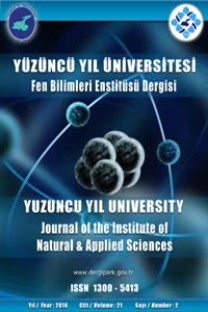Bazı Zirai Bitkilerin Kök Çevresinden Alınan Toprak Numunelerinden Streptomyces Bakterilerinin izolasyonu ve Mikrobiyal Aktivitelerinin Araştırılması
Streptomyces, Karakterizasyon, Biyolojik Kontrol, Mikrobiyal Aktivite
Determination of Antimicrobial Activity of Streptomyces Strains isolated from around and root soil of some agricultural plants
___
- Adams, P.B. (1990). The potential of mycoparasites for biological control of plant diseases. Annual Review of Phytopathology 28, 59-72.
- Annaliesa, S. Huddleston, L., Neil Cresswell, M. Cristina, P., Neves, John E. Beringer, Simon Baumberg, D. Ianthomas, and E.M. H. Wellington. Molecular Detection of Streptomycin-Producing Streptomycetes in Brazilian Soils Applied and Environmental Microbiology, Apr. 1997, p. 1288–1297 Vol. 63, No. 4, 1997.
- Atalan, E., Manfio, G.P., Ward, A.C., Biosystematic studies on novel Streptomyces from soil. Antonie van Leeuwenhoek 77: 337-353.
- Bowers, J.H., Kinkel, L. & Jones, K.
- Bull, A.T., Goodfellow, M. (2000). Search and discovery strategies for biogechnology: the pardigm shift. Microbiology and Molecular Biology Review 64.
- Elo S, Maunuksela L, Salkinoja- Salonen
- Huddleston AS, Cresswell N, Neves MCP,
- Liu, D., Kinkel, L.L., Eckwall, E.C., Anderson, N.A. and Schottel, J.L. (1997) Biological control of plant disease using antagonistic Interactions and Biological Control (Andow, D.W.R.D.A. and Nyvall, R.F., Eds.), pp. 224-239. Westview Press, Boulder.
- Ryan, A.D. and L. L. Kinkel (1997). Inoculum Density and Population Dynamics of Suppressive and PathogenicStreptomycesStrains and Their Relationship to Biological Control of Potato Scab Biological Control, Volume 10 (No:3): 180-186.
- Schottel, J.L., K. Shimizu, and L.L. Kinkel. 2001. Relationships of in vitro pathogen inhibition and soil colonization to potato scab biocontrol by antagonistic Streptomyces spp. Biol. Control 20:102-112.
- Taddei, A., Rodriues, M.J., Marquez- Wilchez, E. & Castelli, C. (2005). İsolation and identification of Streptomyces spp. From venezuelan soils: Morphological and biochemical studies. Microbiological Research :1-10.
- Trejo-Estrada, S.R., Sepulveda, R.& Crawford, D.L. (1998). In vitro and in vivo antagonism od Streptomyce s violaceusniger YCED-9 against fungal pathogens of turfgrass. World Journal of Microbiology and Biotechnology 14. 865-872.
- Wang Y, Zhang ZS, Ruan JS, Wang YM, Ali SM. (1999) Investigation of actinomycete diversity in the tropical rainforests of Singapore. Journal of Industrial Microbiology and Microbiology 23: 178-187.
- Yi, Y., Kim, S., Kim, M., Chaoi, G.J., Cho, K.Y., Song, J. & Lim, Y. (2004). Antifungal activity of Streptomyces spp. against Puccinia recondita causing wheat leaf rust. Journal of Mic. Biotechnology 14(2): 422-425.
- ISSN: 1300-5413
- Yayın Aralığı: 3
- Başlangıç: 1995
- Yayıncı: Van Yüzüncü Yıl Üniversitesi Fen Bilimleri Enstitüsü
Sıfır Ağırlıklı Sayma ile Elde Edilen Veriler İçin Çok Seviyeli ZIP Regresyon
Suna AKKOL, Hayrettin OKUT, Sanem ŞEHRİBANOĞLU
Türkiye Florası'na Ait Hypericum L. Cinsinin Tehlike Kategorileri ve Bulunan Yeni Türleri
Şavşat (Artvin) Yöresinin Bazı Liken Türleri ve Likenlerin Ekonomik Değerleri
Avni ÖZTÜRK, Suzan ÖZTÜRK YILMAZ, Zeynep Büşra ALTUN
Erdal ÖĞÜN, Ekrem ATALAN, Kerem ÖZDEMİR, Müslüm YILDIZ
Lactobacillus Brevis Mikroorganizmasının Çoğalma Kinetiğinin Cevap Yüzeyi Yöntemi ile İncelenmesi
Aybek Yiğit, Nahit Aktaş, Tekin Şahan
Van'da Büyükbaş Hayvan Besilerinde Kullanılan Yemler ve Besi Şekillerine İlişkin Bir Anket Çalışması
